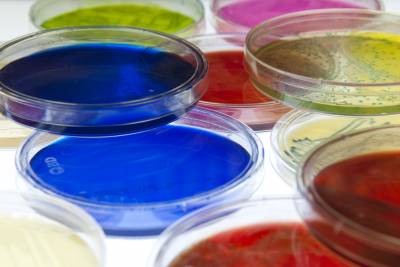Establishing a System for Record Keeping
Fanny Hesse changed the field of microbiology by bringing the solid-media-making-knowhow from the kitchen to the laboratory. She pioneered the use of agar as a “solid” medium for growing microbes. You can be like Fanny, too!
Materials
Corner Store: Grocery Items
- Pasteurized Apple Juice
- Agar-Agar
Common Items
- Stove, Hotplate, or Microwave (some way to heat up the media and melt the agar-agar)

Lab Materials
- Petri Dishes (or any traditional culture dish-like vessel that is sterile or can be sterilized)
Making and Pouring Agar Plates at Home
Agar plates for microbiology are available for purchase on Amazon, but you are limited by their media selection. I prefer to try out “bespoke” media — like apple juice, some fruit puree that I made, or even sweetened tea — as a base to which I add Agar-Agar powder.
Here is what you need to make agar plates:
- Select vessels that are sterile or can be sterilized. Traditional culture dishes for creating solid media plates are petri dishes, which can be purchased on Amazon. Feel free to select something else if you already have an option that will work.
- Decide what your nutrient media will be. For example, this could be apple juice, as described above.
- Get some Agar-Agar, which can be purchased online. It is a little different from the agar that is found in the lab, but it works!
- You will need a stove, a hotplate, a microwave, or some way to heat up the media and melt the agar-agar
To make your agar plates:
- Determine how the total volume of media that you need to make. Add this media to a pot or vessel that can be brought to a high temperature. Try to use mL as a volume unit.
- Using a scale, weigh out the agar-agar so that it is 1.5% of the total volume. Try to use grams as a weight unit.
- For example, if you are making 100mL of apple juice solid media, you should combine 100mL of apple juice media with 1.5g of agar-agar
- Apply heat to the juice-agar mixture. If you are using a stovetop or hotplate, watch that you are not overboiling. If you are using a microwave, you can microwave for 1 minute, swirl, and repeat until the agar is fully dissolved.
- Be careful when looking / swirling the container — it can get very hot! Make sure you are using the appropriate laboratory safety to avoid getting burned
- When you swirl, you should NOT see little specks floating around. If you do see these little specks, keep heating as the agar-agar is not fully dissolved
- Once the agar-agar is fully dissolved into the liquid media, allow the mixture to cool slightly (you don’t want to melt the container you are pouring into, especially if it is plastic). The ideal pouring temperature is about 50C, which is warm to the touch, but should not feel too hot to hold.
- While the media is cooling, set up your plates or vessels that will hold the media. Be sure the area that will be used to pour plates is clean and clutter-free.
- When the media is cool enough for you to handle, begin to pour! Slowly drizzle the media-agar mixture into the dish until it covers the surface. Once enough media is in the dish, apply the dish cover and allow it to fully cool to room temperature.
- Plates should be stored in the fridge, wrapped in foil or plastic. Be sure plates are fully cool before putting them into the fridge or else you will have a ton of condensation form inside the plate.
- To use your plates, take them out of the fridge and allow them to come to room temperature before inoculating with your microbes.
In general:
- 10cm culture dishes each take about ~20mL of media.
- 6cm dishes take ~10mL of media.
Example:
| Ingredient | Per dish | For 10 dishes |
| Liquid Media (juice, puree, sweetened tea, etc…) | 20ml | 200mL |
| Agar-Agar | 0.3g | 3g |
If you would like to see how we make agar plates in the laboratory, you can check out this video: https://www.youtube.com/watch?v=J8diy2O723o&list=PLjLcKccsgV84uICqbRidi-FJ1lB1JXbrL&index=8
